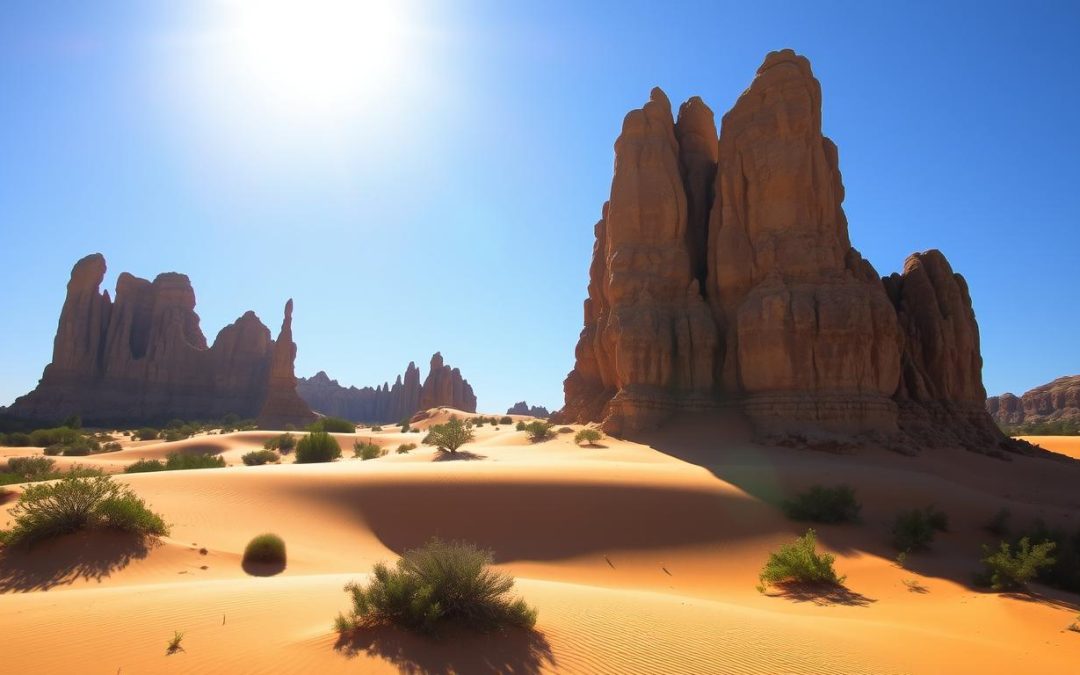Have you ever seen nature turn limestone into amazing shapes that make you wonder? Nambung National Park, 200 km north of Perth, is a place of wonder. It has the Pinnacles Desert, a unique landscape that’s a must-see.
Western Australia is home to incredible natural sights. Nambung National Park is more than a place to visit. It’s a journey through time, with limestone pillars that tell stories of the past.
Exploring this place, you’ll see limestone shapes made from ancient sea shells. It’s like stepping into a dream world. Nambung National Park offers scenic drives and walks, perfect for those who love nature and adventure.
Key Takeaways
- Located just 200 km from Perth in Western Australia
- Home to the spectacular Pinnacles Desert with unique limestone formations
- Offers diverse activities for nature lovers and photographers
- Features limestone pillars reaching heights of up to 3.5 meters
- Provides insights into fascinating geological history
Discovering the Ancient Limestone Formations of the Pinnacles Desert
The Pinnacles Desert is a geological wonder in the Australian Outback. It shows us a unique landscape shaped by time and nature. Located about 200 km north of Perth, it’s in Nambung National Park. Here, thousands of limestone formations amaze everyone.
Formation Process and Geological History
Exploring the Pinnacles starts with learning how they were made. These limestone pillars come from a long geological process:
- Marine shells built up on the ocean floor
- Calcium carbonate layers formed over millions of years
- Sea levels dropped, changing underwater landscapes
- Wind and plants shaped the limestone into unique forms
Unique Characteristics of the Pinnacles
The Pinnacles Desert has limestone formations that amaze visitors. Some key features include:
- Limestone pillars up to 4 meters tall
- Diverse shapes, from sharp columns to weathered structures
- Golden sands contrast with the limestone
- A surreal landscape that looks like another world
Desert Landscape Features
Exploring the Pinnacles Desert, you’ll see a unique ecosystem. Spinifex hirsutus and rare plants live here. They thrive alongside unique wildlife, showing nature’s amazing adaptability.
“The Pinnacles are not just rocks, they are a testament to the incredible sculpting power of time and environmental changes.”
Planning Your Visit to Nambung National Park
Get ready for an amazing eco-tourism adventure at Nambung National Park, just 200 km north of Perth. Start planning your trip to make the most of this unique desert landscape.
- Entrance Fee: $15 per vehicle
- Accessibility: Suitable for all vehicle types
- Recommended Visit Duration: 1-3 hours
Seasons can really make your visit better. Spring brings extraordinary wildflower displays, turning the desert into a colorful scene from July to November. Summer is warm, great for early morning walks. Autumn and winter are cooler, making for a more comfortable visit.
“The Pinnacles await your discovery – prepare for an extraordinary journey through Western Australia’s most unique landscape.”
Essential Packing Recommendations
- Plenty of water
- Sun protection (hat, sunscreen)
- Comfortable walking shoes
- Camera for capturing memories
For the best photos and views, visit early morning or late afternoon. The light then highlights the Pinnacles’ amazing shapes.
| Season | Best Features | Recommended Activities |
|---|---|---|
| Spring (July-November) | Wildflower bloom | Photography, hiking |
| Summer (December-February) | Warm temperatures | Early morning exploration |
| Autumn/Winter (March-August) | Cooler weather | Comfortable walking, fewer crowds |
Your trip to Nambung National Park will be an incredible journey through Western Australia’s most fascinating landscapes.
Exploring the Pinnacles Desert Discovery Centre
Your adventure in Nambung National Park starts at the Pinnacles Desert Discovery Centre. It’s a key spot to learn about this amazing landscape. The centre offers a deep dive into the area’s unique geology and ecology.
Interactive Exhibits and Displays
Step inside to see the Pinnacles Desert come alive. You’ll find interactive exhibits that show:
- How the limestone pillars were formed
- The desert’s ecosystem
- The local Indigenous culture
Educational Programs and Resources
The centre has lots of educational stuff for Wildlife Watching fans and nature lovers. You can enjoy:
- Documentaries on local wildlife
- Guided educational tours
- Expert talks on the area
Visitor Facilities and Amenities
Get ready for your Scenic Trails adventure with these amenities:
| Facility | Details |
|---|---|
| Restrooms | Clean, well-maintained facilities |
| Gift Shop | Local souvenirs and educational materials |
| Picnic Areas | Shaded spaces for relaxation |
“The Discovery Centre transforms your park visit from a simple trip to an immersive learning experience.” – Park Ranger
Before you explore the desert, talk to the knowledgeable staff. They can give you great tips for your journey through this unique landscape.
Scenic Driving Trail Through the Pinnacles
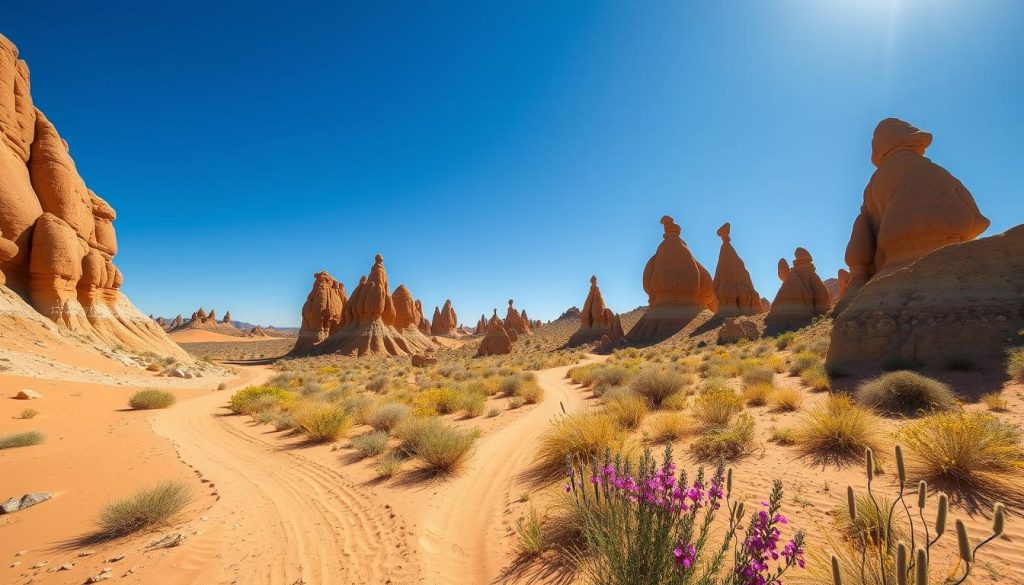
Discover the stunning Pinnacles Desert on a scenic driving trail. It’s a unique way to see Western Australia’s amazing landscapes. The 4.5-kilometer gravel loop is perfect for those who love exploring Desert Landscapes in Nambung National Park.
Start your adventure at the Discovery Centre. Here, you’ll drive through thousands of limestone formations. It’s a 30-minute drive, but give yourself at least an hour to take it all in.
Key Features of the Scenic Driving Trail:
- Total Trail Length: 4.5 kilometers
- Estimated Driving Time: 30-60 minutes
- Terrain: Well-maintained gravel road
- Vehicle Accessibility: Suitable for all vehicle types
There are parking spots along the way for you to stop and take photos. You might also see emus and kangaroos in their natural habitat.
Pro Tip: Keep your camera ready – each turn reveals a new perspective of this otherworldly Desert Landscapes.
Always follow the park’s rules to protect the environment. By doing so, you help keep these Scenic Trails beautiful for others to enjoy in the future.
Walking Trails and Desert View Lookout Experience
Nambung National Park is a top spot for hiking and nature fans. Its unique landscape lets you explore the Pinnacles Desert up close.
The park’s Scenic Trails show off its amazing geological wonders. The Desert View Walk is a key path for those wanting to dive into the desert.
Desert View Walk Highlights
The 1.6-kilometer loop trail takes you through limestone formations. You’ll see:
- Breathtaking limestone pillar landscapes
- Stunning desert terrain variations
- Unique geological formations up close
Photography Hotspots
Photography lovers will love the Desert View Lookout for its panoramic views. The trail has great spots for photos, especially during:
- Golden hour sunrise
- Dramatic sunset periods
- Mid-morning soft lighting
Safety Tips for Desert Hiking
Remember these important tips for your desert hike:
- Carry plenty of water
- Wear sun protection
- Use strong hiking shoes
- Stick to the marked trails
“Preserve the delicate desert ecosystem by practicing ‘Leave No Trace’ principles during your exploration.”
The Pinnacles Desert walking experience is a mix of natural beauty and adventure. It’s a must-see for outdoor lovers and photographers.
Wildlife and Flora in Nambung National Park
Explore the vibrant ecosystem of Nambung National Park, a hidden gem for wildlife enthusiasts. It covers nearly 17,500 hectares, offering a unique look at Western Australia’s biodiversity.
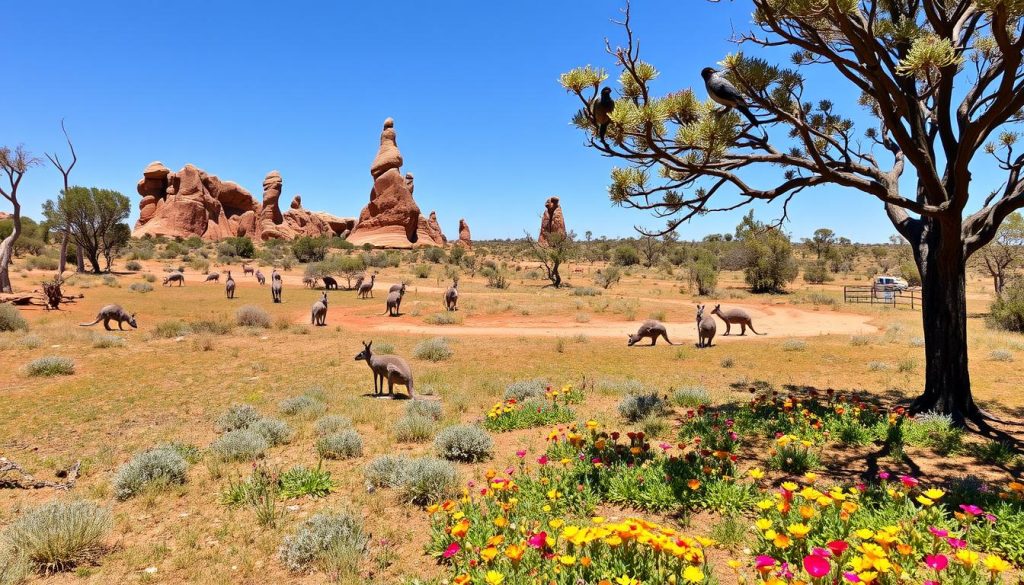
The park’s diverse wildlife makes it a fascinating place. You’ll see many remarkable species during your visit:
- Emus strutting across the desert landscape
- Colorful honeyeaters and parrots
- Western grey kangaroos
- Geckos and skinks adapted to arid conditions
“Nature’s resilience shines through in the most unexpected places,” local wildlife expert remarks about Nambung’s ecosystem.
Indigenous culture deeply respects this environment. The landscape shows a story of survival. Plants and animals are perfectly adapted to the harsh desert.
| Wildlife Category | Common Species |
|---|---|
| Birds | Black cockatoos, honeyeaters |
| Mammals | Western grey kangaroos, possums |
| Reptiles | Sand goannas, bobtails, geckos |
In spring, the park comes alive with wildflowers. Wattles, banksias, and myrtles cover the landscape. This creates a stunning scene that draws nature lovers and photographers.
Remember to observe wildlife from a distance. Stay on designated paths and respect this delicate ecosystem during your wildlife watching adventure.
Best Time to Visit and Seasonal Highlights
Nambung National Park is a top Eco-Tourism spot for those who love the outdoors. The park changes with the seasons, offering a new adventure each time you visit.
Western Australia is famous for its wildflower bloom, lasting six months. About 60% of these flowers are found nowhere else. This makes the park a colorful and textured wonderland.
Wildflower Season Experience
The best time to see wildflowers is from July to November. It’s a chance to see nature’s beauty up close. You’ll see:
- Vibrant native wildflower blooms
- Stunning desert landscape contrasts
- Optimal photography conditions
- Mild temperatures perfect for exploration
Weather Considerations
Knowing the weather is key to planning your trip. Western Australia’s climate varies by season:
- Summer (December-February): Temperatures can reach 40-50°C
- Autumn (March-May): Comfortable temperatures around 30°C
- Winter (June-August): Cooler temperatures in the low 20s
- Spring (September-November): Ideal for wildflower viewing
Peak Visiting Hours
For the best experience, visit early morning or late afternoon. These times are great for:
- Softer light for photography
- Increased wildlife viewing opportunities
- Cooler temperatures
- Reduced crowd levels
“Each season in Nambung National Park tells a unique story of natural beauty and resilience.” – Local Park Ranger
Before you go, check the park’s website for updates and entry details. A $15 entry fee per vehicle helps keep the park beautiful and protected.
Nearby Attractions: Lake Thetis and Cervantes
Your adventure at Nambung National Park doesn’t stop at the Pinnacles Desert. There’s more to explore nearby. You’ll find two amazing places that offer unique experiences and natural wonders.
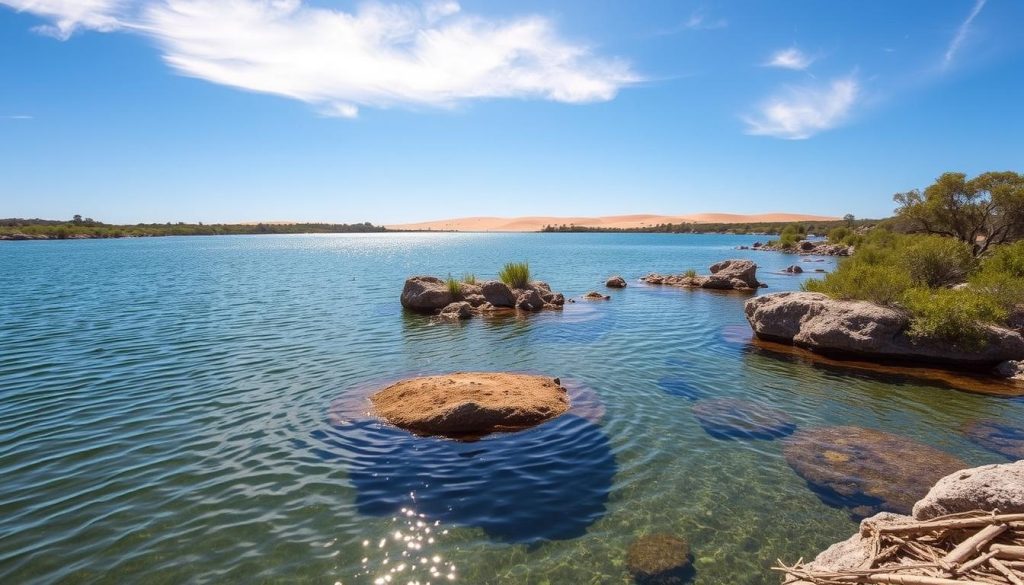
Lake Thetis: A Living Geological Treasure
Lake Thetis is a must-see for nature lovers. It’s a hypersaline coastal lake with thrombolites. These are living structures that have been around for over 3,000 years. They give us a peek into Earth’s ancient past.
- 1.5-kilometer walking trail around the lake
- Informative viewing platforms
- Unique opportunity to observe million-year-old microbial structures
Cervantes: Coastal Charm and Seafood Delights
Cervantes is a fishing town 22 kilometers north of the Pinnacles. It’s perfect for Outdoor Adventure lovers. The Lobster Shack is a highlight, where you can see how lobsters are processed and enjoy fresh seafood.
“Cervantes captures the essence of Western Australia’s coastal lifestyle – relaxed, beautiful, and brimming with natural wonders.”
Exploring the Region
When you visit Cervantes, you can:
- Tour the Lobster Shack
- Swim at beautiful beaches
- Check out Thirsty Point Lookout for stunning views
- Go whale watching during migration season
These attractions near Cervantes add to your Pinnacles experience. They show the wide range of Eco-Tourism options in Western Australia.
Photography Tips for Capturing the Pinnacles
Nambung National Park is a unique place for photographers. The Pinnacles offer special spots for capturing Desert Landscapes. They challenge and inspire photographers to tell stories with their images.
Getting the right shot of the Pinnacles depends on timing. The golden hours, just after sunrise and before sunset, make the desert magical. This is when light and shadow create amazing scenes.
- Choose early morning or late afternoon for soft, warm lighting
- Experiment with different camera angles
- Use wide-angle lenses to capture expansive views
- Include elements for scale in your compositions
Professional photographers suggest using cameras with quick shutter response. The Sony A7r and Nikon D800E are great for desert shots. They offer amazing detail.
| Photography Equipment Recommendations | Best Settings |
|---|---|
| Wide-angle lens (16-35mm) | Low ISO (100-400) |
| Tripod for stability | Small aperture (f/8-f/16) |
| Neutral density filters | Manual focus |
“The Pinnacles are not just a landscape, but a storytelling opportunity waiting to be captured through your lens.”
Always respect the environment when you’re taking photos. Stay on the paths and don’t harm the desert. Your photos can show the beauty of Nambung National Park. They can also help protect its natural wonders.
Conservation and Park Guidelines
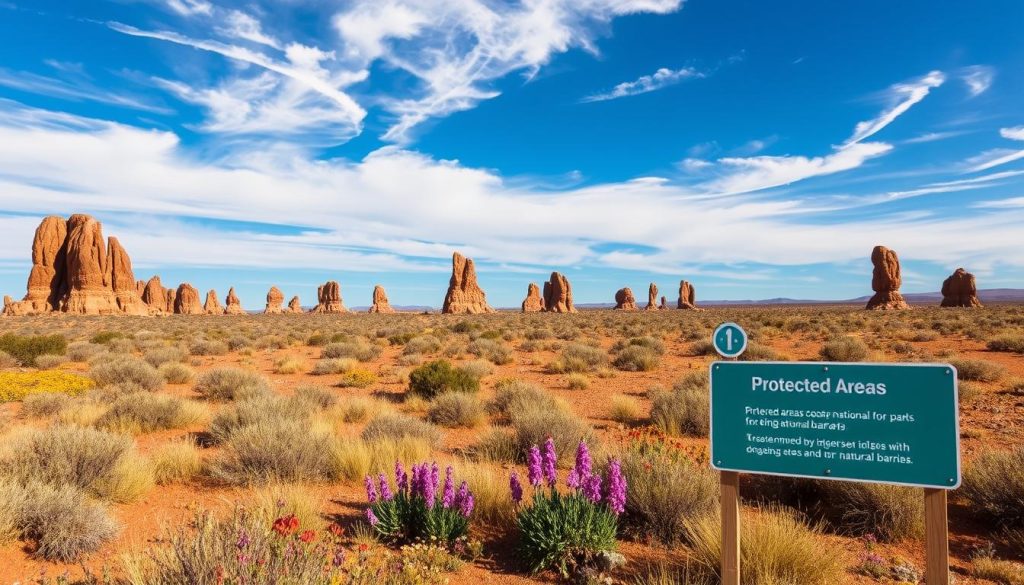
Protecting Nambung National Park’s delicate ecosystem is key. As a visitor, your role in preserving this unique landscape is vital. The park’s Indigenous Culture and natural heritage need respectful interaction with the environment.
Key guidelines for responsible park exploration include:
- Stay on designated walking trails and driving routes
- Never remove rocks, formations, or plant specimens
- Avoid climbing the fragile limestone Pinnacles
- Respect wildlife by maintaining a safe distance
- Properly dispose of all waste
“Take only photographs, leave only footprints” – National Parks Conservation Motto
Understanding the ecological sensitivity of the Pinnacles Desert is crucial. The limestone formations show millions of years of geological history. Minimal human intervention ensures their preservation for future generations.
Eco-Tourism principles are key to enjoying Nambung National Park. Visitors should minimize environmental impact by:
- Using designated camping areas
- Following fire safety regulations
- Conserving water resources
- Respecting cultural and natural heritage sites
By following these guidelines, you help protect this extraordinary natural wonder.
Nambung National Park, Western Australia: Best Things to Do – Top Picks
Nambung National Park in Western Australia is a must-see for any adventurer. It’s home to the Pinnacles Desert, where over a thousand limestone pillars stand tall. This creates a landscape that feels like another world.
Driving through the Pinnacles Desert is a highlight. You’ll see limestone pillars up to 3.5 meters high. It’s a paradise for photographers, with golden sands and limestone making for amazing photos.
The park is also great for wildlife and nature fans. You can walk trails, see native plants, and maybe spot local animals. It’s close to Cervantes, making it a top spot for those wanting to see Western Australia’s beauty.
Nambung National Park has something for everyone. Whether you love photography, nature, or adventure, it’s a place you won’t forget. So, grab your camera, stay hydrated, and get ready for an amazing trip.
The above is subject to change.
Check back often to TRAVEL.COM for the latest travel tips and deals.
Here are some Tours & Sightseeing suggestions that might pique your interests!
